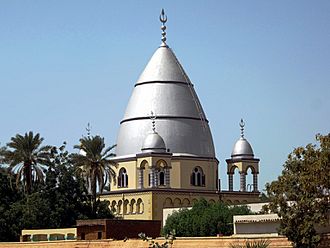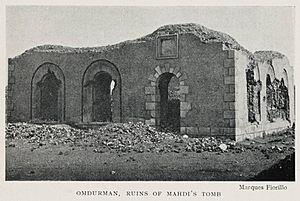The Mahdi's tomb facts for kids
Quick facts for kids The Mahdi's Tomb |
|
|---|---|
 |
|
| General information | |
| Type | Qubba |
| Town or city | Omdurman |
| Country | Sudan |
| Coordinates | 15°38′23″N 32°29′20″E / 15.639746351197402°N 32.48889139833799°E |
| Completed | 1885 |
| Renovated | 1947 |
The Mahdi's Tomb, also called a qubba, is a famous building in Omdurman, Sudan. It is where Muhammad Ahmad was buried. He was a powerful leader who led a big uprising in Sudan in the late 1800s.
Muhammad Ahmad's followers created the Mahdist State in 1885. This happened after they won the Siege of Khartoum. Muhammad Ahmad died soon after this victory. He was buried in Omdurman.
The Mahdist State was then led by Khalifa Abdullahi. But in 1898, a combined force from Britain and Egypt defeated the Mahdists. This force was led by Lord Kitchener. Their victory happened at the Battle of Omdurman. This battle marked the end of the Mahdist State.
After the battle, Lord Kitchener ordered that the Mahdi's tomb be badly damaged. It was hit by gunfire from ships. The tomb was later rebuilt in 1947. This was done under the guidance of the Mahdi's son, ʿAbd-al-Raḥman al-Mahdī. Today, the tomb is next to the Khalifa House Museum. UNESCO has listed it as a site of 'outstanding cultural value'.
Contents
The Mahdi's Story
The Mahdiyya Movement
In 1881, Muhammad Ahmad declared himself the 'Mahdi'. This means 'the Expected Rightly-guided One'. He said he was a successor to the Islamic prophet Muhammad. He called on his followers to join a holy war, or jihad. This war was against the Turco-Egyptian rulers of Sudan.
People in Sudan were unhappy with the government. They had to pay very high taxes since the 1820s. Also, European countries started to have more control over Egypt's government in the 1870s. This led to Europeans and Americans getting important jobs in Sudan. Many of these officials were Christian, like General Charles Gordon. This made many Sudanese Muslims question the religious side of the rule.
There was also anger because European pressure made the Egyptian government try to stop the slave trade. This upset many traders in Sudan.
The Mahdist Victory
Many Sudanese tribes and religious groups joined the Mahdi's army. They were all unhappy with the Ottoman-Egyptian rule. The Mahdi united his followers by calling them anṣār. This name was used for the first followers of the Prophet Muhammad.
The Mahdist state was formed after four years of fighting. The fighting ended with the 1885 Siege of Khartoum. During this siege, the British governor-general of Sudan, General Gordon, was killed. Muhammad Ahmad al Mahdi died unexpectedly six months after this victory. He was buried in Omdurman. During the time of Mahdist rule, his tomb became the most sacred place in Sudan.
The Tomb's Damage
In 1896, British forces were sent to take back control of Sudan. Many people saw this as revenge for General Gordon's death. His death had caused a lot of anger in Britain.
After the Battle of Omdurman, the dome of the qubba was destroyed. This was done by gunfire from Lord Kitchener's small Nile fleet. The Mahdi's body was removed from the tomb. His head was also removed. This act was meant to mirror General Gordon's death by Mahdist forces in 1885. The Mahdi's body was then thrown into the Nile River.
It was said that Lord Kitchener kept the Mahdi's skull. There were rumors that he planned to use it as a drinking cup or an ink well. Winston Churchill later wrote that Kitchener "carried off the Mahdi's head in a kerosene can as a trophy". The skull was later reportedly buried in Wadi Halfa.
Tomb Pieces in the UK
Some parts of the tomb were taken to Britain as trophies. Many of these pieces are now in museums and other places in the UK. At least three large brass decorations from the tomb's domes still exist. One is at the Royal Engineers Museum in Kent, England. Another is at Blair Castle in Scotland. A third one is at the Khalifa House Museum in Omdurman, Sudan. This museum is right next to the rebuilt Mahdi's tomb.


